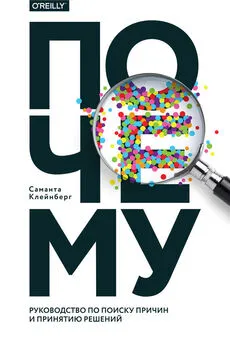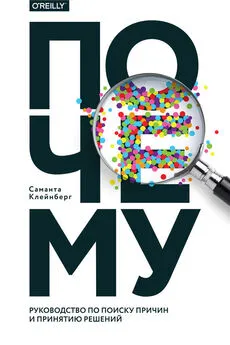Саманта Клейнберг - Почему
- Название:Почему
- Автор:
- Жанр:
- Издательство:Литагент МИФ без БК
- Год:2017
- Город:Москва
- ISBN:978-5-00100-593-3
- Рейтинг:
- Избранное:Добавить в избранное
-
Отзывы:
-
Ваша оценка:
Саманта Клейнберг - Почему краткое содержание
Книга будет интересна аналитикам, философам, исследователям, медикам, экономистам, юристам, начинающим ученым, всем, кто имеет дело с массивами данных и хочет научиться критическому мышлению.
На русском языке публикуется впервые.
Почему - читать онлайн бесплатно полную версию (весь текст целиком)
Интервал:
Закладка:
Если оставить в стороне вопрос, действительно ли разные сроки наказания снижают вероятность рецидива преступлений, и если не задумываться о корректности показателей, увязывающих последнее значение и число людей с различными характеристиками [438], следует ли пользоваться подобной информацией, определяя срок наказания по приговору суда?
Нельзя дать положительный ответ только потому, что некую причину можно использовать для более точного прогнозирования или принятия решений. Методы установления причинно-следственных связей могут только сказать, действительно ли среди каких-то групп больше рецидивистов, но умолчат о том, должно ли справедливое общество использовать подобные групповые свойства, чтобы суровее наказывать отдельных граждан.
Одна из опасностей, подстерегающих тех, кто слишком углубляется в большие объемы данных в поисках корреляций, состоит в незнании механизма действия отдельных вещей. При этом выводы о причинности могут применяться в оправдание несправедливых и дискриминационных практик, сохраняя видимость справедливости и объективности.
Ответственное использование причин означает, что необходимо оценивать не только статистическую и методологическую основательность заключений, но также их этический базис и последствия.
Вместо того чтобы все автоматизировать, лучше комбинировать преимущества вдумчивого человеческого суждения с достоинствами компьютеров, которые способны обрабатывать громадные количества данных. Каждый раз, оказавшись лицом к лицу с причинными зависимостями, мы должны не просто выискивать доказательства в их пользу, а подвергать их допросу, словно следователь с подозреваемым.
Не косвенное ли доказательство (как корреляция), прослеживается ли мотив (механистическое объяснение того, почему причина должна произвести следствие)? Имеются ли смягчающие обстоятельства, например общая причина или некоторое искажение данных?
Если затратность и риск, сопутствующие нашим заключениям, возрастают, так же должна расти и весомость доказательств. И если невозможно с достаточной долей достоверности определить причину, нужно быть готовыми учесть эту неопределенность, когда мы просто не знаем, что за причина имела место. И продолжать поиск.
Благодарности
Эта книга стала возможной только благодаря организациям, финансировавшим мои труды в области причинности. Во время исследований и написания книги я получала помощь Национальной медицинской библиотеки Национальных институтов здравоохранения США (НИЗ) и Национального научного фонда (ННФ). Любые мнения, выводы, заключения и рекомендации, которые приводятся в этой книге, принадлежат мне и необязательно отражают взгляды ННФ или НИЗ.
Я посвящаю книгу моей матери, которая стала ее истинной причиной.
Библиография
Afari, N. and Buchwald, D. (2003). Chronic Fatigue Syndrome: A Review. American Journal of Psychiatry , 160(2): 221–236.
Ahn, W.K. and Bailenson, J. (1996). Causal Attribution as a Search for Underlying Mechanisms: An Explanation of the Conjunction Fallacy and the Discounting Principle. Cognitive Psychology , 31(1): 82–123.
Ahn, W.K. and Kalish, C. W. (2000). The role of mechanism beliefs in causal reasoning. In F. C. Keil and R. A. Wilson (eds.), Explanation and cognition , pp. 199–225. The MIT Press, Cambridge, MA.
Ahn, W.K., Kalish, C. W., Medin, D. L., and Gelman, S. A. (1995). The role of covariation versus mechanism information in causal attribution. Cognition , 54(3): 299–352.
Alberts, B. (2011). Retraction of Lombardi et al. Science , 334(6063): 1636–1636.
Alexander, J. (2012). Experimental philosophy: An introduction . Polity, Cambridge, UK.
Alicke, M. D., Rose, D., and Bloom, D. (2011). Causation, Norm Violation, and Culpable Control. The Journal of Philosophy , 108(12): 670–696.
Alter, H. J., Mikovits, J. A., Switzer, W. M., Ruscetti, F. W., Lo, S. C., Klimas, N., Komaroff, A. L., Montoya, J. G., Bateman, L., Levine, S., Peterson, D., Levin, B., Hanson, M. R., Genfi, A., Bhat, M., Zheng, H., Wang, R., Li, B., Hung, G. C., Lee, L. L., Sameroff, S., Heneine, W., Coffin, J., Hornig, M., and Lipkin, W. I. (2012). A Multicenter Blinded Analysis Indicates No Association between Chronic Fatigue Syndrome/Myalgic Encephalomyelitis and either Xenotropic Murine Leukemia Virus-Related Virus or Polytropic Murine Leukemia Virus. mBio , 3(5): e00266– е00212.
Andersen, H. (2013). When to Expect Violations of Causal Faithfulness and Why It Matters. Philosophy of Science , 80(5): 672–683.
Anderson, C. (2008). The End of Theory: The Data Deluge Makes the Scientific Method Obsolete. Retrieved from http://archive.wired.com/science/discoveries/magazine/16–07/pb_theory .
Appelbaum, B. (2011). Employment Data May Be the Key to the President’s Job. The New York Times , June: p. A1.
Aristotle (1924). Metaphysics . Oxford University Press, Oxford. Edited by W. D. Ross.
Aristotle (1936). Physics . Oxford University Press, Oxford. Edited by W. D. Ross.
Badler, J., Lefèvre, P., and Missal, M. (2010). Causality Attribution Biases Oculomotor Responses. The Journal of Neuroscience , 30(31): 10517–10525.
Badler, J. B., Lefèvre, P., and Missal, M. (2012). Divergence between oculomotor and perceptual causality. Journal of Vision , 12(5): 3.
Baird, S., Ferreira, F. H. G., Ӧzler, B., and Woolcock, M. (2013). Relative Effectiveness of Conditional and Unconditional Cash Transfers for Schooling Outcomes in Developing Countries: A Systematic Review. Campbell Systematic Reviews , 9(8).
Baker, S. G. and Kramer, B. S. (2001). Good for Women, Good for Men, Bad for People: Simpson’s Paradox and the Importance of Sex-Specific Analysis in Observational Studies. Journal of Women’s Health & Gender-Based Medicine , 10(9): 867–872.
Bareinboim, E. and Pearl, J. (2012). Controlling selection bias in causal inference. In Proceedings of the 15th International Conference on Artificial Intelligence and Statistics .
Barnett, L. and Seth, A. K. (2014). The MVGC multivariate Granger causality toolbox: A new approach to Granger-causal inference. Journal of Neuroscience Methods , 223: 50–68.
Beasley, N. A. (1968). The extent of individual differences in the perception of causality. Canadian Journal of Psychology , 22(5): 399–407.
Bechlivanidis, C. and Lagnado, D. A. (2013). Does the “Why” Tell Us the “When”? Psychological Science , 24(8): 1563–1572.
Beecher, H. K. (1955). The Powerful Placebo. Journal of the American Medical Association , 159(17): 1602–1606.
Begley, C. G. and Ellis, L. M. (2012). Drug development: Raise standards for preclinical cancer research. Nature , 483(7391): 531–533.
Bennett, C. M., Baird, A. A., Miller, M. B., and Wolford, G. L. (2011). Neural Correlates of Interspecies Perspective Taking in the Post-Mortem Atlantic Salmon: An Argument For Proper Multiple Comparisons Correction. Journal of Serendipitous and Unexpected Results , 1: 1–5.
Bhatt, A. (2010). Evolution of Clinical Research: A History Before and Beyond James Lind. Perspectives in Clinical Research , 1(1): 6–10.
Bickel, P. J., Hammel, E. A., and O’Connell, J. W. (1975). Sex Bias in Graduate Admissions: Data from Berkeley. Science , 187(4175): 398–404.
Blackwell, B., Bloomfield, S. S., and Buncher, C. R. (1972). Demonstration to medical students of placebo responses and non-drug factors. The Lancet , 299(7763): 1279–1282.
Blatchford, P. and Mortimore, P. (1994). The Issue of Class Size for Young Children in Schools: What can we learn from research? Oxford Review of Education , 20(4): 411–428.
Bohrnstedt, G. W. and Stecher, B. M. (eds.) (2002). What We Have Learned about Class Size Reduction in California . American Institutes for Research, Palo Alto, CA.
Bollinger, B., Leslie, P., and Sorensen, A. (2011). Calorie Posting in Chain Restaurants. American Economic Journal: Economic Policy , 3(1): 91–128.
Bond, R. M., Fariss, C. J., Jones, J. J., Kramer, A. D., Marlow, C., Settle, J. E., and Fowler, J. H. (2012). A 61-million-person experiment in social influence and political mobilization. Nature , 489(7415): 295–298.
Born, M. and Einstein, A. (1971). The Born Einstein Letters: Correspondence between Albert Einstein and Max and Hedwig Born from 1916 to 1955 with commentaries by Max Born . Macmillan Press, Basingstroke, UK. Translated by Irene Born.
Boyd, C. M., Darer, J., Boult, C., Fried, L. P., Boult, L., and Wu, A. W. (2005). Clinical Practice Guidelines and Quality of Care for Older Patients With Multiple Comorbid Diseases: Implications for Pay for Performance. JAMA , 294(6): 716–724.
Brandt, M. J., IJzerman, H., Dijksterhuis, A., Farach, F. J., Geller, J., Giner-Sorolla, R., Grange, J. A., Perugini, M., Spies, J. R., and Van’t Veer, A. (2014). The Replication Recipe: What makes for a convincing replication? Journal of Experimental Social Psychology , 50: 217–224.
Broadie, S. (2009). The Ancient Greeks. In H. Beebee, C. Hitchcock, and P. Menzies (eds.), The Oxford Handbook of Causation , pp. 21–39. Oxford University Press, Oxford; New York.
Buchanan, M. (2007). Statistics: Conviction by numbers. Nature , 445: 254–255.
Читать дальшеИнтервал:
Закладка:






![Саманта Даунинг - Моя дорогая жена [litres]](/books/1070823/samanta-dauning-moya-dorogaya-zhena-litres.webp)



